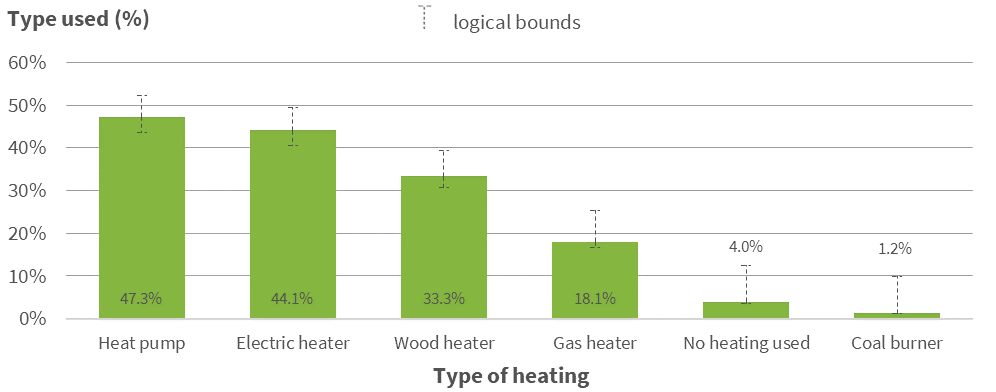Home heating
This section presents additional information about the indoor environment, specifically about New Zealand households with no source of heating.
Houses with no source of heating are likely to be cold and below recommended temperatures. They may also be more likely to be damp and mouldy. Regional climate differences across New Zealand may also influence home heating patterns.
Cold homes can cause respiratory problems and other serious health problems [1]. Indoor temperatures below 16°C increase the risk of respiratory infections, and below 12°C stress the cardiovascular system [1].
Indoor dampness and mould can lead to asthma exacerbation in children [1], and is also associated with an increased risk of respiratory tract infections and bronchitis [2].
On this page:
More than 60,000 homes without a heating source
In 2018, 60,800 households did not have a source of home heating, which is 4.0% of households. Houses in northern New Zealand were more likely to have no source of home heating. Northland and Auckland had higher proportions of homes without a heating source.
Figure 1: Main types of heating used to heat dwellings, New Zealand, 2018

Note: Multiple responses were allowed, values therefore do not add up to 100%. Logical bounds give the lower and upper bounds of what the percentage could be, allowing for the missing data due to implementation problems with the Census.
Source: Census 2018
Poor quality housing and health
Some forms of home heating can also affect our indoor and outdoor environment.
In 2018, 7.5% of homes used bottled gas for heating. In some homes, bottled gas is used with unflued gas heaters. These heaters release carbon monoxide, nitrogen dioxide and water vapour [3].
For more information on home heating, go to the types of home heating webpage.
You can also read more about the following health conditions:
- asthma
- lower respiratory tract infections.
Information about this data
Source: Stats NZ - New Zealand 2018 Census of Populations and Dwellings
Definition: Main types of heating were classified as: no heating required, heat pump, electric heater, gas heater (fixed gas heater and portable gas heater), wood heater (wood burner and pellet fire), coal burner, and other types of heating. Multiple responses were allowed.
2018 Census data: Stats NZ has noted that the 2018 Census had a lower than expected response rate resulting in the introduction of new methods to produce the dataset, including using data from alternative sources. Stats NZ and the 2018 Census External Data Quality Panel (EDQP) have produced a rating system to help the users understand the quality-related issues and impacts of the 2018 Census dataset.
EHI have decided to update this information based on the documentation relating to the ‘Main types of heating and fuel types used to heat dwellings’ indicator. The EDQP rating for this indicator was moderate and the response rate was 92.3%. Further information about the Stats NZ and EDQP documentation can be found in https://www.stats.govt.nz/2018-census/data-quality-for-2018-census
Logical bounds: The 2018 Census suffered from implementation problems, and as a result, had a lower than expected response rate resulting in missing data. We therefore present the lower and upper logical bounds of what the percentage could be, allowing for the missing data. The lower bound is calculated as the count among the total value, whereas the upper bound is calculated as the sum of the count and unknowns among the total value.
Time trend: There was a change in the census question; therefore no comparison with previous Census years can be made.
